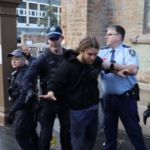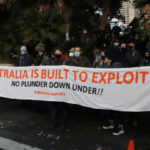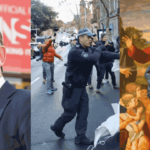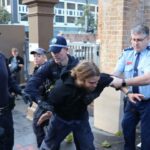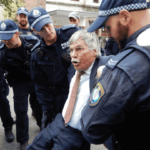Disruptive Protest Is Necessary, Says Extinction Rebellion, as SA Antiprotest Regime Likely to Pass
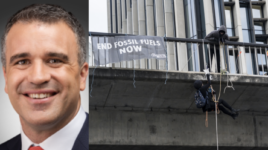
Amnesty International organised a 500 hundred strong protest in the Adelaide CBD last Friday evening, as civil society groups, unions and climate defenders marched united in their demand that the Malinauskas government’s proposed extreme antiprotest regime is not enacted into law.
The regime is in response to a series of actions that Extinction Rebellion carried out a fortnight ago, with one involving an activist abseiling from a bridge blocking morning peak hour traffic, having led Liberal opposition leader David Speirs to take to talkback radio to demand severer protest penalties.
Following Speirs’ Thursday morning on-air suggestions, SA premier Peter Malinauskas said in an interview later that morning that he’d be passing laws that crackdown on unauthorised protest, if only he could obtain “bipartisan approval”, of which he obviously already had.
And as SA Greens MLC Robert Simms put it last week, “The move was announced on talkback on Thursday morning and by lunch time the bill had already passed the House of Assembly.”
The legislation goes before parliament this Tuesday, and whilst it will be up for debate, with the bipartisan support it has, it’s likely to pass. Although Simms has announced, he’ll be moving an amendment to see a 12 month sunset clause inserted into the legislation.
The criminalisation of protest
The Summary Offences (Obstruction of Public Places) Amendment Bill 2023 makes drastic amendments to section 58 of the Summary Offences Act 1953 (SA), as it increases the applicable fine for obstruction of a public place by over 6,000 percent and it adds an ability to imprison protesters.
Currently, obstruction of a public place in SA can see an individual fined $750. However, Malinauskas considers a $50,000 fine a more reasonable punishment for individuals who cause nonviolent disruption. Indeed, the premier also believes such actions warrant up to three months in prison.
And if it happens to be that an unauthorised protest doesn’t cause any disruption, well these penalties apply anyway, as new subsection 58(1a) states that “a person may be found guilty” of this offence if their “conduct directly or indirectly obstructed the free passage of a public place”.
Yet, these laws are no anomaly. The NSW Perrottet government passed similar measures a year ago that see those who obstruct bridges, tunnels, roads or major facilities in an unauthorised manner facing a $22,000 fine or up to 2 years in gaol.
Shooting the messenger
The primary purpose of this authoritarian approach to civilians making their political voices heard, as they’re not afforded a place in parliament, is to demonise climate defenders to the point that the public doesn’t hear their message, which is that more extreme weather events are on their way.
However, whilst politicians like Perrottet, Minns, Malinauskas and Speirs are taking this bipartisan approach to the climate movement, they’re conveniently establishing laws that can be applied to all forms of protest and to all causes.
Sydney Criminal Lawyers spoke to an Extinction Rebellion South Australia spokesperson about why the group was protesting APPEA, the peak body representing local oil and gas corporations, and the fact that unauthorised and disruptive protests are the form of demonstration that’s most effective.
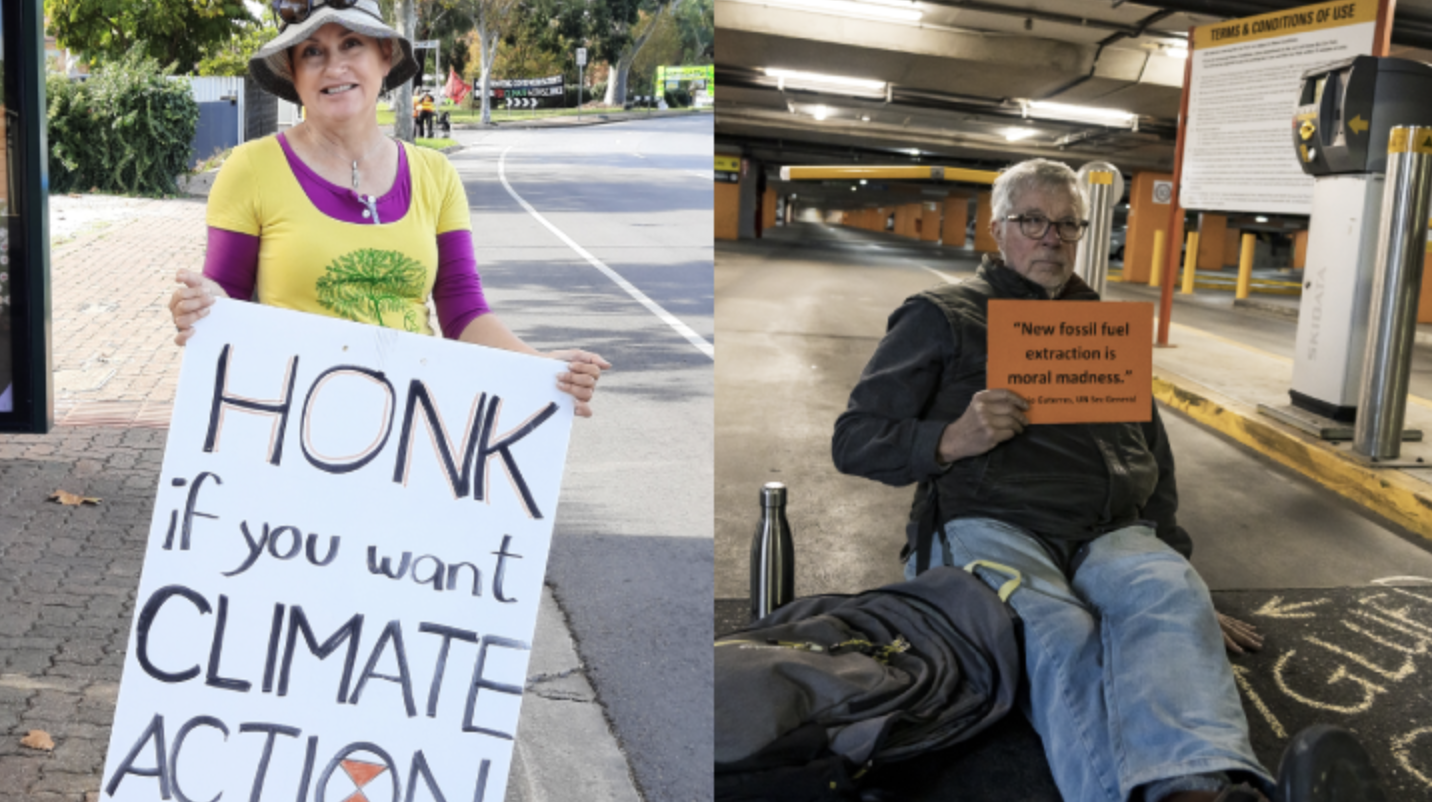
Firstly, XR South Australia commenced five days of nonviolent direct actions in the Adelaide CBD on Sunday 14 May, with the intention of highlighting the climate crisis. What sort of impact would you say the actions had?
The climate change protests marked the Australian Petroleum Production and Exploration Association (APPEA) Conference, which was taking place in Adelaide.
One of the aims was to create a movement of movements. This was addressed during the first action: a forest of banners gave unwelcoming messages to delegates arriving for the APPEA conference at the airport.
Extinction Rebellion collaborated with the Australian Religious Response to Climate Change, Scientist Rebellion, the Romero Community, No Nuclear Subs SA, Wage Peace, and Fossil Free/350.org.
There was also a collaborative effort to put on the Climate Rave 3000 dance event on the final day, which was mostly organised by South Australia Grassroots Ecosystem and was aimed at the student group.
Extensive work to contact people and make arrangements was necessary for both actions.
Our presence and the nature of our events would have increased the cost of APPEA for the organisation, the venue and the government.
We hope that people attending the conference were impacted by information and challenges to the industry, but this is difficult to measure.
While members of the public found it difficult to avoid the discussion on climate change. Some deliberately engaged through social media, with 3,200 engagements on Facebook. Our Facebook reach was up 368 percent and Instagram was up by 665 percent.
As usual, some engagement seemed to be from an organised group of negative respondents who were operating out of apparently fake social media accounts. We have not analysed the nature of positive and negative comments.
So, why did Extinction Rebellion SA consider it necessary to stage these actions, whilst the APPEA conference was taking place at the Adelaide Convention Centre?
Continued government inaction on climate change and strong alignment with the fossil fuel industry presents a major risk of further global heating.
From the published APPEA conference program, it was evident that the industry is set on a pathway of misinformation and the capture of governments.
This needed to be countered and no other environmental group in South Australia was taking the lead in any representations to the government or to the industry.
There was much evidence of the serious threats APPEA presents. APPEA corporations are not heeding UN warnings on the need for no new gas, oil and coal projects.
At the recent conference, they were planning to open up new gas and oil reserves. And this needed to be exposed.
APPEA corporations were also claiming that carbon capture and storage (CCS) would be further developed to offset emissions, which we understand to be failing and expensive, with no impact on scope 3 emissions, and likely causing the expenditure of more energy. This too needed to be exposed.
Further, APPEA conference information ignored the fact that renewables technology is rapidly increasing in efficacy and rapidly decreasing in price.
These corporations were pushing back on increased government regulation, which included comments in the conference program.
And what also needed exposing is that state and federal governments are captured by the APPEA corporations.
Although hardly any effort was required after the SA premier and energy minister rushed to support the conference and declare the state is “at their disposal”.
Similarly, federal resources minister Madeline King was effusive in her recommendations for more gas supply.
APPEA corporations greenwashed by taking a special focus on hydrogen during the conference.
Hydrogen is a pet project of the state government and is most probably the premier’s effort to be seen as leading the new energy drive.
Clearly, hydrogen produced by fossil fuels is a backward step, and there’s no guarantee that new hydrogen projects, like the Whyalla Steel Works, will use green hydrogen.
And what was the response of authorities on the ground to your actions, which included an XR member abseiling off the Morphett Street Bridge and disrupting morning peak hour traffic?
In general, the responses of police were measured and courteous. Activists were nonviolent, as this is a tenet of XR actions, and they were also courteous and rational.
The activists involved deployed safety marshals and police liaison officers to increase the level of safety and of information available.
An exception to this were the remarks made on a public radio interview by the SA police commissioner, which were to the effect that while he would not take this action, he would have liked to be able to cut a rope on which the activist had abseiled from the bridge.
This could only be interpreted as evidence of intimidation and it’s also likely to encourage or be seen to condone threats or violent behaviour among other individuals.
The danger presented by this can’t be over emphasised in the light of the social media responses: there are always a number of profane and also violent and threatening posts.
Serious profanity posts are deleted and responders who issue serious or repeated threats are blocked from the site. About five responders have been blocked to date for this campaign.
In response to the climate actions, the Malinauskas government drafted a bill, which passed the SA lower house on the same day it was produced, which will see draconian penalties applied to the type of actions XR conducted over the period.
What’s XR SA’s reaction to these proposed laws?
With this rushed attempt to change protest laws. The state government kowtowed to the opposition and introduced an amendment to the legislation aimed at disruptive protests.
This is a kneejerk reaction triggered by civil rights protests in several states and a collaborative effort to stamp out climate protest. The amendments passed the lower house and are awaiting review in the upper house.
XR SA members aren’t surprised by this reaction but are surprised by the haste, lack of dignity and the government’s willingness to fall into step behind the state opposition, who first proposed the changes.
Spontaneously, civil liberties groups, concerned environmental groups, lawyers, Amnesty, unions and other groups have collaborated to protest formally about these changes.
Media approaches, a rally and other actions have taken place in response. XR SA members are collaborating with this effort.
But we don’t yet know the impact the proposed changes will have on activists and protest actions.
Malinauskas’ proposed antiprotest regime is not the first of its type in Australia. Indeed, the NSW government was the first to impose severe penalties on unauthorised protests last year in response to rising direct actions.
So, considering, as you say, you weren’t surprised by the reaction of the state, why forge ahead with these unauthorised protests, that while nonviolent are disruptive?
We cannot separate the impact of climate information from many different sources, from the impact that XR actions have.
We know that the recent state and federal elections featured climate change as a key issue, although cost of living and lack of housing have recently escalated.
We also cannot measure and isolate the impact of XR actions, nor measure the attitudes of people to XR as an organisation or to XR activities.
We know that we are marked out as radical activists even though about 90 percent of our activities are not disruptive in any way.
In general, there are two or more activities per week when averaged over a year. Very few of these receive media attention.
The only activities causing some degree of shock or disruption receive media attention.
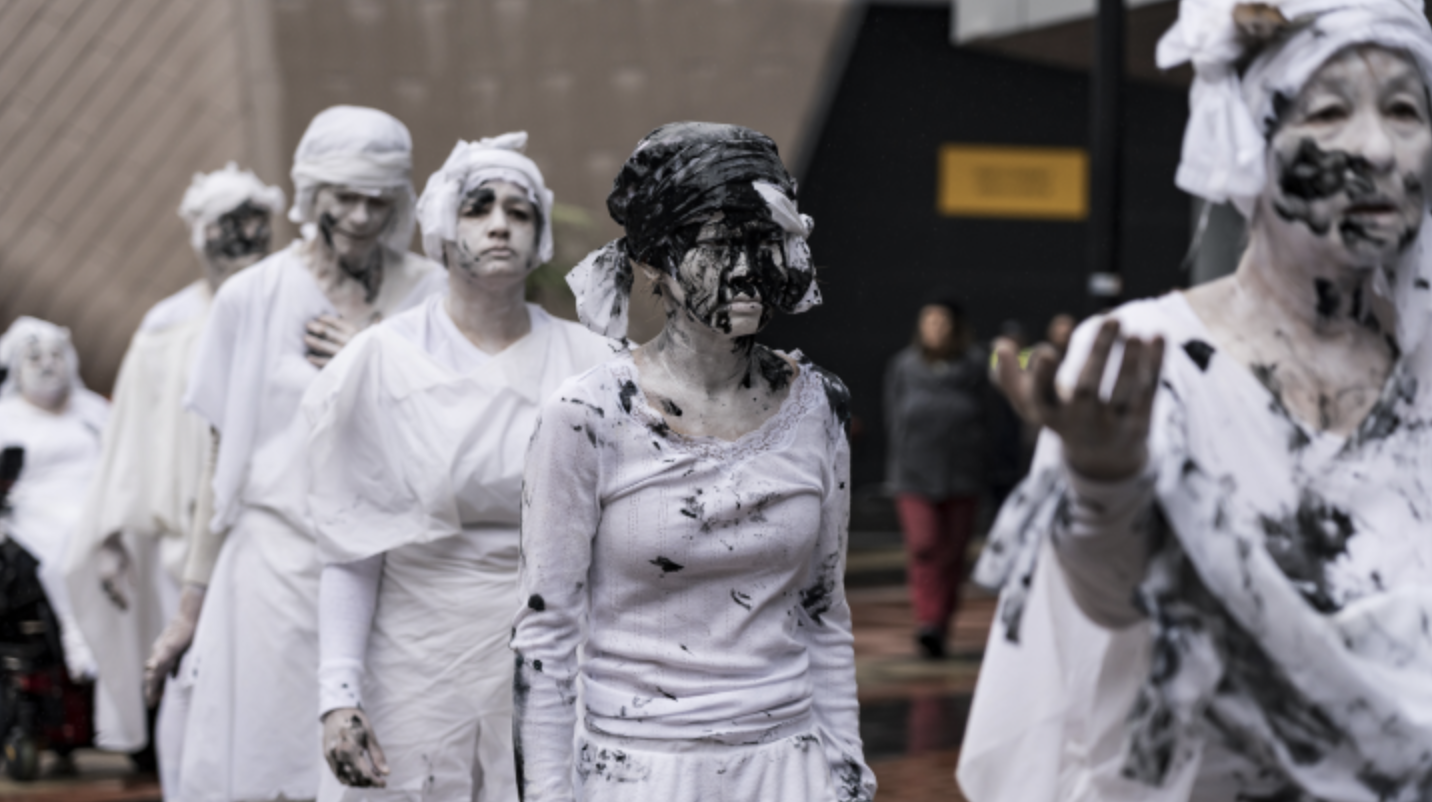
How would you describe the reactions on the part of Australian authorities in regard to civilians trying to raise the very real crisis people and planet are facing in the most effective manner available to them?
Repeatedly, individuals and members of parliament use the mantra that there are “right and wrong” ways to protest and that protests must not inconvenience the community.
This reveals a lack of understanding of the democratic tradition of protest, and the necessity of making protest disruptive in some way.
Examples of this are the denial or restriction of service, as in strikes, by crossing boundaries of socially accepted behaviour, as in bizarre behaviour or nudity, or via irritation, such as music, noise or interruption.
Extinction Rebellion, as a worldwide movement, is focused on putting pressure on governments as the key entity in society that is tasked with protecting the safety, health and comfort of citizens.
Failure to protect the community against the dangers of global heating is a dereliction of this duty of care.
However, governments are unwilling to admit this. A clear example was the Federal Court case brought by school students against the then minister for environment Sussan Ley for breach of duty of care.
This was found by Justice Mordecai Bromberg but later, an appeal was successful.
Increasingly, XR groups put pressure on corporations because of the strong links between governments and corporations, and the influence of corporations.
So, government actions are necessitating so-called “wrong” protests?
XR also intentionally works by shifting the so-called Overton window.
This window of what is considered normal and average opinion about social and political issues appears to shift when people are seen to move to one or other of the extreme points in the spectrum of opinion – say from climate denial to high levels of concern.
As people discuss issues and observe others around them and as debate continues, the Overton window of “normal and average” can shift to what was once considered a more radical view.
Recent examples of this include the gay marriage debate or acceptability of atheism and agnosticism.
We can tell through personal interactions and by examining social media that many people feel extremely frightened and desperate about climate change and express admiration and gratitude for people taking strong actions.
So, there’s method to what the authorities claim is XR’s madness?
Groups such as Climate for Change have studied and analysed attitudes in the community and know that there are segments where climate denial or resistance to information are strong and entrenched.
XR groups pay attention to this body of research and do not intend to waste effort on changing such attitudes.
Strongly supportive groups of people come from all walks of life, a recent example was a group of Country Women’s Association members spontaneously thanking one of our activists.
And these reactions vary from active in related organisations, through to inactive but supportive.
The middle-range group between deniers and supporters are unwilling to engage and appear to be frightened about climate change but feel powerless to act.
And lastly, why have governments, like that in SA and NSW, decided to crack down so harshly on the climate movement now, especially as recent elections have shown the will to take adequate climate action is strong in the community?
We suspect that the recent reaction of the SA government comes from a deep-seated unease.
Information from the IPCC and related reports is difficult to avoid, and conservative elements in society are issuing climate warnings – such as fire services, health authorities and insurance companies.
Shooting the messenger is an understandable reaction and is often expressed by characterising the messenger as irresponsible, troublemaking or even attention-seeking.
Therefore, we can view government inaction as normal and expected, especially when influenced by state capture.


